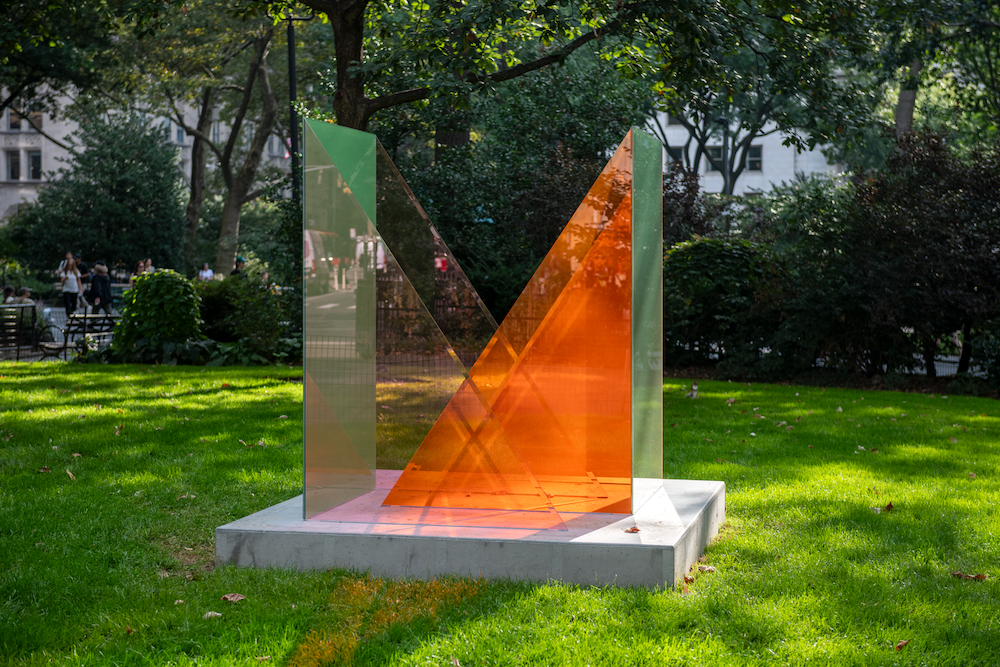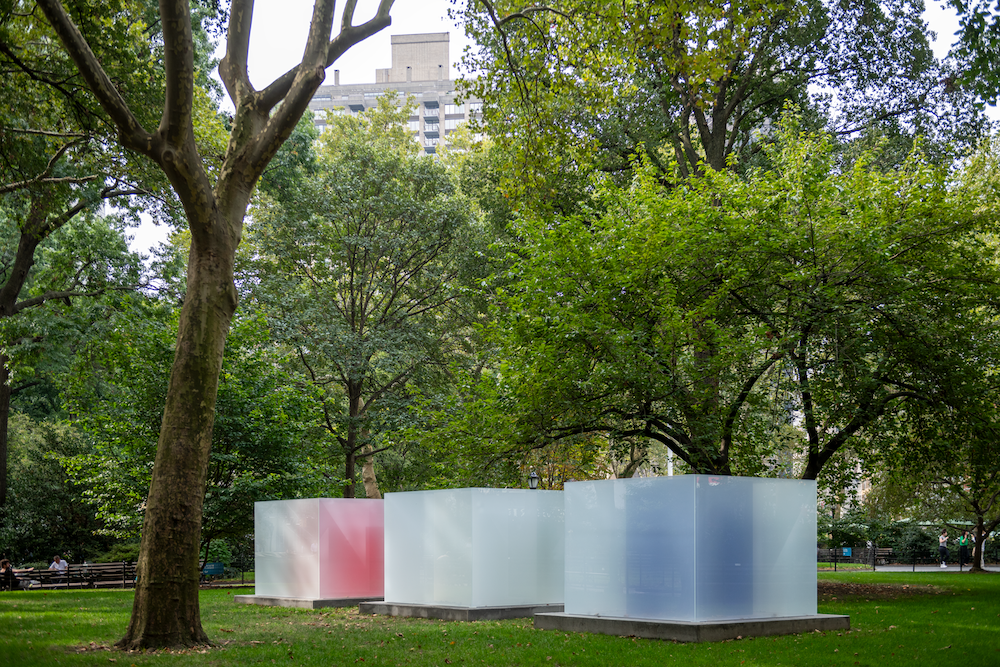Denise Markonish on “Improvisations in the Park”
For his largest public art project to date, Larry Bell has transformed Madison Square Park with Improvisations in the Park, an ambitious exhibition that amplifies the subtleties of light, weather, and urban motion across the park’s landscape. Commissioned by Madison Square Park Conservancy and debuting two new sculptures made specifically for the site, the exhibition extends Bell’s seven-decade investigation into perception and the immaterial qualities of glass. The works shift tonally by season, sunlight, and the presence of passing bodies. As the Park’s newly appointed Martin Friedman Chief Curator, Denise Markonish stepped into her role just as the project was taking shape. In the following conversation with Jenny Wang, Markonish reflects on Bell’s practice, the role of improvisation, and how Madison Square Park continues to evolve as a platform for public art.
Xuezhu Jenny Wang: How did this collaboration come about? How does Larry Bell fit within the larger curatorial vision of Madison Square Park Conservancy? More broadly, what is the larger curatorial direction for the nonprofit?
Denise Markonish: I should note that I’m very new—I started here at the Madison Square Park Conservancy at the end of June. Larry was chosen by my predecessor, Brooke Kamin Rapaport, who curated here for over a decade. It was an incredibly inspired choice. I admire curators who can immediately see an artist’s potential in a specific space.
When I arrived, the checklist for the exhibition was already in place, but everything else—from site placement to the opening, the upcoming symposium, and the catalog—was something I worked on with the team. I feel lucky to have joined in time to help shepherd the project and to work with Larry, whom I’ve long admired.
The park is not submission-based; like most museums, the curatorial staff selects the artists. Historically, the park has often commissioned artists who haven’t yet had major public art presentations in New York, or even in the public realm at all. Larry has shown outdoors a few times—he had a piece on the Whitney’s sculpture terrace—but this is his largest public art exhibition ever, and certainly the largest in New York. It’s an extraordinary opportunity to present his work at this scale.
XJW: Do you have a vision for the park’s curatorial programming during your tenure?
DM: My vision builds on what the park has always done: bringing exceptional contemporary art to this bustling urban oasis in the middle of Manhattan. That artist-forward ethos won’t change. A few new things we’re working on include projects that aren’t single-artist commissions—a group show is in development, as well as a project involving sound. Ultimately, the goal is to continue presenting exciting, ambitious work.
XJW: In the title of the show, improvisation seems to play a central role with a musical connotation. Could you elaborate on how improvisation operates within this exhibition?
DM: For Larry, improvisation is largely about relinquishing control. He chooses color, form, and shape, but in the park, the improvisation happens with the visitors and with the environment. The sun shifts constantly, so the works change throughout the day. As people walk by or catch their reflections, the pieces become performative in these spontaneous, impromptu ways.
Larry collects twelve-string guitars, and I love the parallel—how does musical improvisation translate into sculptures that physically remain in place but are constantly “alive,” shifting because they absorb, reflect, and refract the world around them?
XJW: Have there been any memorable moments of audience engagement or feedback?
DM: Every day in the park, you see people stopping to take photos. One of my favorite moments was when someone set up their camera to record a dance for TikTok in front of one of the pieces. They were standing at an angle where the glass refracted the light in such a way that their reflection appeared three times behind them while they danced in front. I love that the video is somewhere out there online.
XJW: I noticed two 2018 works, Fourth of July in Venice Fog and Blues from Aspen, reference locations outside New York. I was curious about this idea of place and how location might shift meaning.
DM: I don’t think Larry uses place names literally. My impression is that they relate to specific light conditions he experienced. For example, he used to have a studio in Venice Beach, and the “Venice Fog” piece captures the fog rolling in from the Pacific. I’m not entirely sure about the Aspen reference, but I assume it relates to how light behaves there.
The point is that even though these are material objects, they evoke something immaterial—light, fog, atmosphere. Those sensations exist anywhere, so the works ultimately transcend their place-based references.
XJW: The artist also mentions that when the works “return home,” they’ll take on different meanings—that they’ll become something else. Do you think he sees the works as sites where memories accumulate and materialize?
DM: Yes, I love that he said that. Glass seems hard and impermeable, but he thinks of the works as alive—able to hold experience. During installation and opening week, he sat in the park every day, just watching people interact. He said, “I never thought, in all these years of working, I’d see my work with trees and with squirrels.” Whether the sculptures themselves hold those memories or he holds them by witnessing them, I love the idea of the works as living things.
This interview has been edited for length and clarity.





